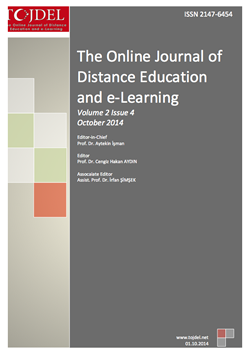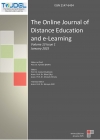TOJDEL - Volume 2 - Issue 4 - October 2014
 Investigating The Use Of Social Networking Tools In Improving Students’ Grammar: A Case Study
Investigating The Use Of Social Networking Tools In Improving Students’ Grammar: A Case Study Amelia Abdullah Talha Taufik
Abstract: The qualitative study is conducted to identify how using emails as a social networking tool can foster and improve students’ grammar. This study employs a case study method as it could investigate new phenomenon within its real context. The samples of this study consist of five secondary school students from Penang. The instruments used in the data gathering process are threads analysis and semi-structured interview. Data is triangulated to justify the learning of grammar among the students. The findings showed notable improvement in the acquisition of grammar among the study respondents. The data also indicate that there is improvement in the motivation level and students are actually having fun using emails in their English classes.
 Attitude Of B.Ed. Students’ Towards Odl Institutions In Tamil Nadu Open University
Attitude Of B.Ed. Students’ Towards Odl Institutions In Tamil Nadu Open University Dr.A.S.Arul Lawrence[1], Dr.C.Barathi[2]
Abstract: The present study aims to probe the attitude of B.Ed. students’ towards ODL institutions in Tamil Nadu Open University. Survey method was employed in the present study. A sample of 293 B.Ed. students studying in Tamil Nadu Open University was selected by simple random technique. The data was collected by Students’ Attitude and Perceptions Rating of Open and Distance Learning Institutions Inventory (SAPRODLII) developed by Ojo, D. O., & Olankulehin, F. K. (2006). SPSS-17 Package was used for analysis of the collected data. The Percentile analysis, mean, standard deviation, level, t-test, ANOVA and chi-square were employed as statistical techniques to analyse the data. The findings show that (1) the attitude of B.Ed. students towards ODL institutions in TNOU is neutral, (2) there is no significant difference in the attitude of B.Ed. students towards ODL institutions in TNOU in terms of (i) gender, (ii) locality and (iii) teaching experience, (3) English medium students are having favourable attitude towards ODL institutions in TNOU than Tamil medium students, (4) Language subject students are having favourable attitude towards ODL institutions in TNOU than arts and science subject students, and (5) there is significant association between age of the B.Ed. students and their attitude towards ODL institutions in TNOU.
 E-Book As Learning Tool: A Review And Focus For Future Research
E-Book As Learning Tool: A Review And Focus For Future Research Azidah Abu Ziden[1], Nur Kaliza Khalid[2]
Abstract: This is a conceptual paper to study the use of e-book as a learning tool. The study reviews literature on the basic concepts of e-books. The paper discusses and analyses on previous studies about e-book and its use in education especially in teaching and learning process. The findings include multiple definitions of e-book, the limitations and advantages that appears to be the most influential in its use in the learning process and whether users perceptions of e-book use has changed over time. This paper ends with discussions on the existing gaps in e-book research and suggestions for future research on how e-book could be used and explored as a teaching and learning tool.
 Blended Learning In A Blended Composition Class: A Case Study In French
Blended Learning In A Blended Composition Class: A Case Study In French Carolyn GASCOIGNE[1], Juliette PARNELL[2]
Abstract: The following pages present a case study examining both faculty and student perspectives of a post-secondary French composition course that is blended in two respects. First, this application may be considered blended because technology is used to mediate portions of instruction. Second, the course is blended in that three formerly distinct classes and levels of instruction are fused into one faculty course assignment. With financial pressures limiting course offerings and forcing technology-mediated solutions at many public universities in the United States, the following study sought to document and describe the effect of a creative course redesign at one institution. Detailed course descriptions, student and faculty surveys, and third-party observations were employed in order gain insight into the impact of the redesign on all parties involved.
 Simultaneous Delivery Of Lectures To Students In A Lecture Room And An Online Meeting Room Using The Adobe Connect Teaching Facility
Simultaneous Delivery Of Lectures To Students In A Lecture Room And An Online Meeting Room Using The Adobe Connect Teaching Facility Chet Geisel
Abstract: INTRODUCTION: The purpose of this intervention was to investigate students’ perspectives of the effectiveness of teaching when two distinct groups were combined during lectures. The two distinct groups consisted of a local (on-campus) cohort, and an online cohort interacting through the Adobe Connect live online teaching facility. METHOD: The combining of lectures involved specific pieces of hardware for various reasons. A pilot study of three lectures was used to ascertain the feasibility of the investigation, after which the remainder of the module was delivered using this simultaneous method. Students were then asked to complete a questionnaire posed using Google Docs, based on their opinions of the entire module.RESULTS: The results showed a spread of opinions among all of the students (n=41), however the overall trend appeared to be in favour of the method of delivery. There were additional comments made (n=3) that focussed on timeliness of answers during the lecture. CONCLUSION: From this investigation, it can be suggested that the effectiveness of teaching when teaching local and online groups simultaneously is not adverse for the module in question. Further implementation of this combined delivery method should be investigated, as well as hardware and software adjustments
 Exam Performance in a Hybrid Course: A Model for Assessing Online and In Class Exam Delivery Modes
Exam Performance in a Hybrid Course: A Model for Assessing Online and In Class Exam Delivery Modes Susan M.Siegmann[1], Danyelle
Moore[2], Christopher P.Aquino
[3]
Abstract: This study involved the impact of different assessment techniques in a higher education hybrid classroom. The study assessed the differences in exam results when student exams were proctored in-class versus online. In a freshmen level international business course twenty-four students participated in the study. The study was conducted with three conditions; students were administered four fifty-question multiple-choice exams with periodic retesting (N=24), a post-exam survey was distributed after exam one which provided feedback regarding student perceptions (N=24), and student feedback regarding the preference of the modes of delivery of exams was noted by the professor throughout the course (N=24). The proctored in-class retest scores for the students after taking the exam online indicated that they retained the material better than when the exam was first administered in a proctored in-class format. In general, exam scores were higher when the exam was administered online verses proctored in-class. The implications of these findings and the model developed by the authors to capture them are discussed herein.
 The Use Of Podcasting Revision Lectures In Improving Learners’ Academic Performance
The Use Of Podcasting Revision Lectures In Improving Learners’ Academic Performance Elias Rankapola
Abstract: Research studies completed on podcasting technology to date concentrated on the acceptance of podcasting technology in the educational settings and the challenges that it poses for higher education institutions and instructors. Very little interest has been accorded to the effect that podcasting could have on the learners’ academic performance. Resultantly, a quasi-experimental study was conducted. The study was completed over a period of 12 months, in which a stratified random sample of 150 learners was selected from a population group of 280 learners at the Tshwane University of Technology. The sample was divided into experimental and the control groups. The assessment marks for four tests of the two groups were compared to determine the effect of the intervention. The outcomes of the study showed a remarkable increase in the overall mean score of the experimental group in comparison to the mean score of the control group. The number of scores which are > 75% have increased significantly and pass rate has improved as compared to the control group scores. These are positive signals of enhanced academic performance. The study concluded that there is a strong correlation between the use of podcasting technology and the learners’ academic performance.
 Best practices: An online doctoral learning experience
Best practices: An online doctoral learning experience Tracy Christianson & Tracy Hoot
Abstract: Online education offers students the flexibility to attend to course work when personal or work commitments conflict with learning. Students who do not have the ability to commute to classes have the opportunity to continue their education online through distance learning. Other benefits to online learning are that students are not limited in their decision based solely on program suitability or availability. This paper reviews the literature on best practices for asynchronous online learning and the factors that students should consider when choosing to enroll in an online program. The authors’ personal journey, beginning at their decision to enroll in an online doctoral education program, to factors that contributed positively to their online experience is discussed.
 Technology Integration at a Crossroads: Dead End Street or New Horizons?
Technology Integration at a Crossroads: Dead End Street or New Horizons? Rogerio Roth
Abstract: The integration of technologies went through various stages, from exacerbated optimism with over-promises to disappointment with the realities, possibilities and daily practices. Thus, the intrinsically interdisciplinary process of effective integration of the technologies to the university teaching practice is becoming less frequent and dystopian, represented by a throwback or absence of these practices. The alternative to the current model can be in a back to the past, not ignoring the technologies, but performing a rereading of good teaching practices, establishing connections and adapting them to needs and local realities. The same technology that massified in virtual form the university can provide the answers and indicate a way back to the quality.
 Factors In Design Of Assessment For Online Courses: Instructors` Reflections
Factors In Design Of Assessment For Online Courses: Instructors` Reflections Shijuan Liu
Abstract: Assessment is acknowledged as a fundamental element in course design (Christen, 2003) and has great impact on teaching and learning (e.g., Anderson, Bauer & Speck, 2002). While much has been written on assessing students in traditional environments, there is a paucity of research on assessment of students in online environments (Reeves, 2000, 2002). This paper reports a study that investigated considerations and rationales that instructors had in design and use of assessment methods in online courses they taught. Twenty instructors teaching online courses at a large public university in the United States were interviewed on a one-on-one basis. Seven factors were identified from the instructors` reflections on their considerations and rationales behind the assessment methods they used, which included: (1) students, (2) motivation, (3) learning, (4) subject areas, (5) programs, (6) characteristics of the online delivery format, and (7) constraints. Each of the factors and their subcategories were reported. Implications of the findings and suggestions for further research were discussed.
 Learning Styles Preferences Among Usm Distance Learners Via Videoconferencing Technology.
Learning Styles Preferences Among Usm Distance Learners Via Videoconferencing Technology. Siti Hajar
Abstract: This study aims to identify the most dominant learning styles of SDE-USM distance learners with the usage of videoconferencing technology. The theoretical foundation for this study is based on Grasha-Reichmann learning styles model such as independent, dependent, competitive, collaborative, avoidant and participative. 394 respondents answered the questionnaire distributed to them and collected data were analysed using descriptive statistics such as means, standard deviations. The SPSS software version 17 was utilised to analyse the data. This study showed that independent learning styles recorder higher mean value as compared to others learning styles. Researchers suggest that further studies should explore other learning style theories with other delivery methods as well as include a larger sample from different institutions.
 Virtual School Leadership: Professional Development Using Digital Technologies in Canada and Haiti
Virtual School Leadership: Professional Development Using Digital Technologies in Canada and Haiti Steve Sider
Abstract: The rapid growth of digital (e-)learning and mobile (m-)learning has created the potential for people to access learning opportunities throughout the world. Although there has been significant research on e- and m-learning (e.g. Valk, Rashid, & Elder, 2010), there has been much less attention given to how school leaders can access these resources for their own professional learning, particularly in the developing world. This study provides an examination of how digital technologies can facilitate learning and professional development of school leaders in Haiti and in other fragile states. The key research question at the center of the study is: How can digital technologies facilitate learning that occurs in a professional learning network built to support educational leadership capacity-building in Haiti? Three key themes developed from the research study: Collaboration, authentic and real-time problem-solving, and engagement. These themes are discussed in relationship to literature that argues for a new understanding of globalization for school leaders (Brooks & Normore, 2010). In the conclusion, the challenges and opportunities of accessing e-learning to support educational leadership capacity-building across borders are discussed.


